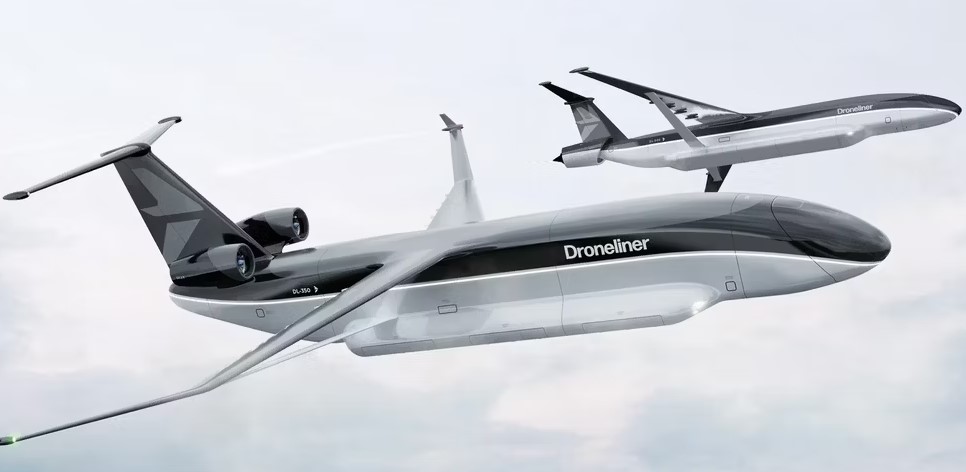Aerospace
Meet The Droneliner, the World’s Heaviest Pilotless Cargo Plane

Droneliner is set to introduce a computerized cargo aircraft that could completely redefine air freight, thereby revolutionizing the aviation industry. This is a groundbreaking development. appropriately named the Droneliner, this cutting-edge system is built to remain in the air indefinitely, ushering in a new era of sustainability and efficiency.
The Droneliner offers a multifunctional platform that goes beyond traditional airfreight and is designed for same-day/next-day bulk cargo delivery worldwide. With its ability to handle both military and civilian containerized intermodal freight, as well as air-to-air refueling, military air-drop capabilities, and disaster relief missions, the Droneliner is a flexible solution for a wide range of global challenges.
Cost Efficiency and Reduced Emissions
One of the main advantages of the Droneliner is its ability to cut air freight expenses by over 70%, which makes it a financially viable substitute for sea freight. Airfreight is now a feasible option for a wider range of goods due to these cost savings, as well as a notable reduction in delivery time and emissions.
The Droneliner comes in two models, the DL200 and DL350, each with its unique specifications. The DL200, a single-engine cargo drone, boasts a 6,500-mile range, carrying 36-40 containers with a payload capacity of 160-200 tons. Meanwhile, the DL350, a dual-engine cargo drone, offers even greater capabilities with three decks, carrying 70-80 containers and a payload capacity of 300-350 tons.
The Droneliner is renowned for its efficiency and cost-effectiveness due to its low-cost modular construction and readily available components. The most fuel-efficient long-haul cargo aircraft available is this one, with to its ultra-low-drag airframe and emphasis on reducing drag.
In addition to its economical and environmental advantages, the Droneliner requires no pilots, contributing to a 90% reduction in handling costs. The innovative roll-on/roll-off freight system ensures a swift 1-hour turnaround time, making it hyperactive and suitable for both military and civilian applications. With a commitment to sustainability, the Droneliner achieves a remarkable 95% reduction in CO2 emissions, setting a new standard for environmentally conscious cargo transportation.

Aerospace
Boeing Transfers Rocket Stage to NASA, Paving Way for Human Moon Mission

Boeing has achieved a significant milestone by providing NASA with the second core stage of the Space Launch System (SLS) rocket.
This crucial component, crafted at NASA’s Michoud Assembly Facility (MAF), is set to propel the Artemis II crew into lunar orbit, marking humanity’s return to deep space after a 50-year hiatus.
The monumental Boeing-built rocket stage, the largest element of the Artemis II mission, will embark on a journey aboard the Pegasus barge, traveling 900 miles to NASA’s Kennedy Space Center.
Comparison of two legendary aircraft B777x vs B747 aircraft:Click here
Upon arrival, it will be meticulously integrated with other essential Artemis II components, including the upper stage, solid rocket boosters, and NASA’s Orion spacecraft within the iconic Vehicle Assembly Building. This intricate integration process is a vital step toward the eagerly anticipated Artemis II launch, slated for 2025.
“Boeing-built products helped land humankind on the moon in 1969, and we’re proud to continue that legacy through the Artemis generation,” remarked Dave Dutcher, vice president and program manager for Boeing’s SLS program. “Together, with NASA and our industry partners and suppliers, we are building the world’s most capable rocket and paving the way to deep space through America’s rocket factory in New Orleans.”
NASA, Lockheed Martin Reveal X-59 Quiet Supersonic Aircraft:Click here
The delivery of Core Stage 2 marks a significant achievement in the evolution of the SLS rocket. Towering over 200 feet and powered by four RS-25 engines, this core stage, coupled with two solid-fueled booster rockets, will generate a staggering 8.8 million pounds of thrust. This immense power is crucial to launching Artemis II and future missions into the vast expanse of space.
The SLS rocket stands unparalleled in its capability to transport both crew and substantial cargo to the moon and beyond in a single launch. Its extraordinary capacity will facilitate the delivery of human-rated spacecraft, habitats, and scientific missions to destinations including the moon and Mars, ushering in a new era of space exploration.
-

 Travel1 week ago
Travel1 week agoAir India to Expand US Operations with Three New Routes After a Decade
-

 Travel2 weeks ago
Travel2 weeks agoWhy We Should Avoid These Stamps in a Passport
-

 Airlines1 month ago
Airlines1 month agoInvestigations Reveal Fake Chinese Titanium in Boeing and Airbus Jets
-

 Tech4 weeks ago
Tech4 weeks agoChina’s CATL Plans 1,800-Mile Electric Plane Launch by 2027
-

 Airport3 days ago
Airport3 days agoTop 10 Largest Airports in the World by Size
-

 Aerospace4 weeks ago
Aerospace4 weeks agoChina’s Fighter Jets Turn Wings into Autonomous Drones
-

 Airlines4 days ago
Airlines4 days agoAir India Rolls Out A350s for Delhi-New York JFK and Newark Routes
-

 Defence3 weeks ago
Defence3 weeks agoBoeing Enhances Chinook with New Engines and Block II Upgrades at $96 Million







